Perforating system improves stimulation results in unconventional completions
Perforating tight formations in horizontal wells presents a dilemma common to unconventional shale plays. Traditionally, operators must choose between running centralizers in the perforating gun string, or letting the string lay naturally on the casing’s inner wall. In centralized perforation strings, the charges utilized are positioned at a constant distance from the target casing’s inner wall. The space between the outer wall of the perforating gun containing the shaped charges and the inner wall of casing is the “fluid gap.” The gap’s influence on charge performance can be predicted and quantified during the stimulation design program.
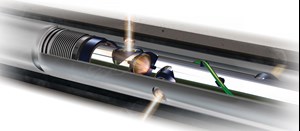
The additional length and diameter of centralizers makes access to highly deviated horizontal wells difficult, if not impossible. Running a perforating string without centralizers improves access but delivers entry holes (EH)—the hole resulting from a shaped charge jet entering the casing—that can vary by as much as 50% between holes on the high side of the casing, compared to those on the low side, Fig. 1.
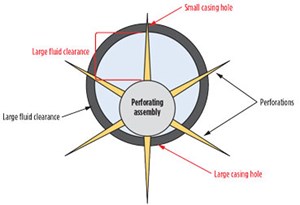
Decentralized perforation strings must work with an asymmetrical fluid gap, which results in widely varying charge performance, including depth-of-penetration and EH size. Engineers select charges to provide adequate depth-of-penetration, small exit hole and consistent entry hole to improve stimulation. Conventional shaped charges are generally selected based on their various performance characteristics; however, they are not designed to account for fluid gap variances. Neither deep penetrating (DP), super-deep penetrating (SDP), or good hole (GH) shaped charges, can provide consistent EH diameter in decentralized applications.
Inconsistent EH sizes make it difficult for stimulation designers to accurately calculate flow area, resulting in variations of proppant distribution and poor stimulation results. Non-uniform EH diameters can result in erosion and slotting of smaller perforations during the stimulation process, leading to under-utilization of the entire perforation set. This can cause slow ramp-up to intended treating pressures, therefore extending pumping time, increasing the volume of frac fluids needed and reducing well stimulation efficiency.
The perforating gun system also directly affects the operational productivity due to its tendency toward human error during the gun loading, arming and assembly processes. A reliable and “dummy-proof” perforating system is required to minimize nonproductive time for the stimulation operation. Pairing the ideal shaped charges with the right perforating gun system is imperative for efficient well stimulation and maximum productivity.
SHAPED CHARGE SOLUTION
To solve the issues surrounding inconsistent entry holes, Hunting’s Titan Division developed the EQUAfrac. With EQUAfrac shaped charges designed specifically to reduce variations in EH diameter, the H-1 optimizes stimulation performance and well production rates in decentralized horizontal well completions.
EQUAfrac technology can provide EH sizes, with less than 7% variation in diameter, regardless of string position, Fig. 2. Depending on the perforating gun size and the type of casing, the system can, in some cases, deliver EH size variance below 3%. This is accomplished via a proprietary shaped charge liner, creating a focused jet more quickly and over a longer gap.
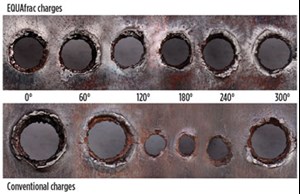
The innovative shaped charge technology can produce consistent entry holes, regardless of the distance from the outer wall of the perforating gun to the inner wall of the casing. Meaningful stimulation improvements result from consistent EH diameters, including reaching the treatment rate faster at a lower pressure.
The frac pumping profile, which consists of the treatment rate, hydraulic horsepower and fluid volume required to reach formation breakdown, is similarly improved. The time, horsepower and volume needed to fracture the formation is decreased, because uniform EH size delivers equal proppant distribution in every hole, 360° around the wellbore. The increased area open to flow leads to consistent pump rates at lower pressures across the stage, Fig. 3. Faster treatments at lower pressures mean less horsepower and fluids, saving time and money during the fracturing process.
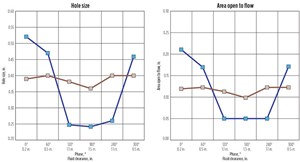
Field trials. To analyze the shaped charge’s performance in a real-world environment, multiple field tests have been performed. The results were then compared to performance delivered by conventional shaped charges in decentralized applications.
In one stimulation case study evaluating pumping profiles after perforating, the 23g EQUAfrac charge outperformed a comparable 23g conventional charge. The conventional charge resulted in breakdown pressure averaging 7,500 psi to 8,300 psi, and treating pressure averaged 8,900 psi. The treating rate averaged around 91 bbl/min. but was inconsistent.
Conversely, the EQUAfrac charge improved break-down pressure, averaging between 7,000 psi and 7,800 psi, or 500 psi less than the conventional charge. The treating pressure using the consistent hole charges averaged around 8,400 psi, which was 6% lower than that of the conventional charges. The treating rate increased 10%, to 100 bbl/min.
Treatment rates were reached faster, at a more consistent rate, when running EQUAfrac, allowing perforations to take higher sand concentrations at a lower pressure. Other field trials also demonstrated improved stimulation results that the consistent hole charges provide.
DEPTH OF PENETRATION
While entry hole consistency is a primary factor in frac design, perforating beyond the drilling-invaded zone is essential for efficient stimulation. The drilling-invaded zone is the rock formation surrounding the outer diameter of the wellbore that was damaged by the concentric pressure of the drilling process. This near-wellbore area has reduced permeability, due to the pulverized material that it contains.
The industry consensus for ensuring depth of penetration—essentially the length of the perforation tunnel—is to extend past the drilling-invaded zone. Shaped charges that cannot penetrate past the invaded zone can hinder stimulation performance, with further negative impact to future production rates.
Perforation penetration is critical to stimulation performance, because the depth of perforation directly affects how the fracture initiates fractures or cracks. Deeper perforations are, on average, easier to initiate and propagate. Deep, consistently formed perforations extending into the virgin formation can significantly reduce breakdown pressure and improve fracture initiation.
A secondary reason for a longer, tapered perforation is that longer perforations are less influenced by the crushed zone surrounding a perforation tunnel than are short perforations. The perforation crushed zone is the region immediately around the perforation tunnel that acts as a barrier to further fracture extension, due to reduced permeability after the perforation event. The perforation jet causes micro-fracturing to the surrounding formation, destroying larger pores and replacing them with smaller ones. Studies have shown that the perforation damage is significantly higher near the perforation entry, compared to the area around the perforation tip further away (SPE paper 51051-MS, Halleck).
APPLICATION CHALLENGES
Since their introduction to the market in 2014, the EQUAfrac charges have completed hundreds of wells, providing a superior hole charge technology for improved frac efficiencies. While consistent EH is imperative for stimulation results that meet or exceed the design requirements, there are other charge performance metrics. The exit hole size, as well as the jet’s depth of penetration, are similarly important. In some cases, a shaped charge manufacturer is forced to sacrifice depth-of-penetration to achieve consistent and adequate EH size.
It is also difficult to devise a consistent and large EH while keeping the exit hole small. The exit hole is the resulting diameter on the perforating gun, formed as the perforating jet leaves the gun. Ideally, the exit hole is as small as possible, so that debris inside of the perforating gun does not follow the jet and plug up the entry hole, rendering the EH effectively useless during stimulation.
The company’s consistent hole-shaped charge solves all three challenges by providing consistent EH size, small exit holes and penetration well beyond the invaded zone. The shaped charges can achieve minimum penetration lengths 2½ times the interior diameter of the wellbore, extending past the low permeability damaged zone caused by hoop stress concentrations. The charges also maintain a beneficial ratio of entry hole size to exit hole size, which minimizes blockages due to debris.
API stressed rock testing. API RP 19B Section 2 testing requires shooting into stressed rock targets to more closely mimic downhole perforation performance in shale formations. In multiple head-to-head tests, the Titan charge averaged roughly 10½-in. of penetration in Section 2 rock tests, above the needed penetration to extend past the invaded zone, into virgin formation, Fig. 4.
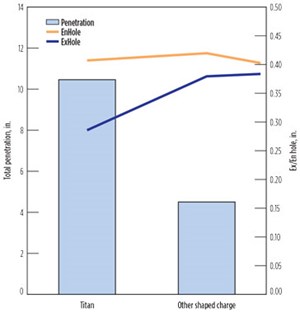
EQUAfrac’s resulting exit hole is significantly lower than the entry hole, as well as the exit hole, compared to the other tested charge. This ideal exit hole to entry hole ratio reduces the likelihood of debris plugging the perforation.
In comparison, a non-company consistent EH charge averaged penetration of less than 4½-in., below the needed penetration to surpass the invaded zone. The other charge also delivered larger exit holes nearly equal to the entry hole, which can attribute to debris filling perforations.
In addition to Section 2 rock tests, an actual well stimulation case study was completed by alternating stages running EQUAfrac and the equivalent other-type consistent hole charge. Analysis of the resulting pumping profiles showed the other-type charge resulted in break-down pressure at an average of 8,400 psi to 9,500 psi, and treating pressure averaged 8,700 psi.
The EQUAfrac charge resulted in break-down pressure averaging around 6,800 psi to 8,200 psi, and treating pressure averaged around 8,100 psi to 8,200 psi. Therefore, the consistent hole charge showed to break down the formation at pressures 13% lower than the other type charge, and the resulting treating pressure was 6% lower. The operator also noted that the new charge took less time to reach treating rate and allowed higher sand concentrations at lower pressures. These results demonstrated that the EQUAfrac charge consistently improved stimulation while decreasing costs.
PERFORATING SYSTEM
To optimize delivery of the consistent hole-shaped charge, the company developed the H-1 perforating gun system, Fig. 5. This system is used in traditional, selective fire, and plug-and-perf operations to improve operational efficiencies and to reduce associated costs. The system is designed for safe and efficient gun loading, arming and assembly, compared to conventional perforating guns.
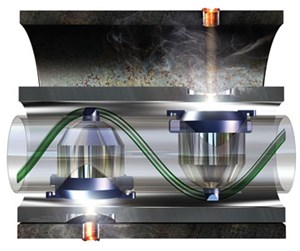
The system loads four times faster than most perforating guns in the field today. To make perforation gun loading even simpler, the company created H-Lok shaped charge technology. These charges simply twist and lock into place.
The H-1 also prevents waste by utilizing predetermined detonating cord lengths that remove the need for measuring and trimming. The biggest time-saver is the elimination of the shooting wire, Fig. 6. While other systems feature “pre-wired” guns, the company’s design eliminates wires entirely, so there is zero risk of associated wiring errors.
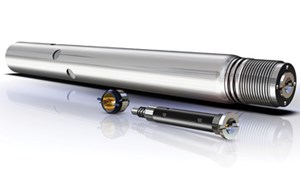
In addition to gun loading, the field arming operation is also much faster and easier, using the new perforating system. It is intuitive and user-friendly because it eliminates wires by using the RF-Safe ControlFire cartridge. The new cartridge allows the user to arm the gun by inserting the cartridge into the pin end of the gun. The cartridge utilizes proven and reliable ControlFire technology, which has a 99.99% success rate with nearly two million runs.
The new perforating system also improves the total length of assembly (footprint) by reducing parts and connections. The tool string footprint is shortened because the box by pin design eliminates tandem subs between perforating guns. The system also improves performance in the wellbore by reducing potential seal failures, because there are no port plugs that can fail. Overall, the system reduces hardware connections by two thirds. These advances create a perforating system that is easier to handle and has reduced opportunities for human error.
CONCLUSION
When completing horizontal shale wells using stage frac techniques, it is imperative to utilize reliable perforating guns and shaped charges that will consistently provide uniform perforations that extend into the virgin formation. Utilizing the provider’s line of shaped charges and the H-1 perforating system will optimize stimulation performance, reduce costs and improve operational efficiency when compared to other perforating systems and shaped charges. ![]()
- Applying ultra-deep LWD resistivity technology successfully in a SAGD operation (May 2019)
- Adoption of wireless intelligent completions advances (May 2019)
- Majors double down as takeaway crunch eases (April 2019)
- What’s new in well logging and formation evaluation (April 2019)
- Qualification of a 20,000-psi subsea BOP: A collaborative approach (February 2019)
- ConocoPhillips’ Greg Leveille sees rapid trajectory of technical advancement continuing (February 2019)


